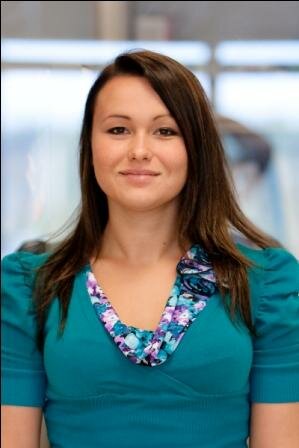|
Below is a snap shot of the work we are doing and the people who are the driving force behind that research. It’s important to remember that while we can be open to everyone about what we are doing in general, there are often times that aspects of this research or recent exciting discoveries need to be held in confidence for a period of time while manuscripts are prepared or IP (intellectual property) is determined. We will update our web page here frequently to try to keep you up to date on the latest research we are performing, as well as what the implications of the research are to our understanding of AS and how this may influence future therapeutic intervention.
Jennifer Daily
 The description of Angelman Syndrome often creates imagery of a singular childhood disorder; however, Angels can be found at all ages. The question of whether a potential therapeutic would be effective in adult Angels is a question we take seriously. This question can be asked hand-in-hand with the question of whether Angelman Syndrome is a developmental disorder with much of the detrimental damage occurring prenatally. Both of these questions can be answered in the AS mouse model in a number of different ways. The description of Angelman Syndrome often creates imagery of a singular childhood disorder; however, Angels can be found at all ages. The question of whether a potential therapeutic would be effective in adult Angels is a question we take seriously. This question can be asked hand-in-hand with the question of whether Angelman Syndrome is a developmental disorder with much of the detrimental damage occurring prenatally. Both of these questions can be answered in the AS mouse model in a number of different ways.
For example, deletion of maternal Ube3a can be induced in an adult “typical” mouse and then evaluated to see if the mouse now will develop the symptoms of AS to the same extent as one that developed with the missing Ube3a gene. This strategy is available through current genetic technology, but the production of these AS inducible mice are expensive to produce and it is difficult to make a complete maternal deficient mouse. Instead, we have chosen to use an alternative method of viral transfection; in essence to replace the missing gene in neurons of the brain of an adult AS mouse model.
What are the results of these experiments?
Jennifer finds that many of the symptoms observed in the AS muse model are rescued including; the cognitive defect assessed through the evaluation of associative (fear conditioning) and spatial (hidden platform water maze) learning and memory.
These results suggest that at least the cognitive disruption associated with maternal Ube3a deficiency can be rescued in the adult AS mouse model. As an extension, these data suggest that the same may be true for adults with AS. While gene replacement therapy is much too invasive and experimental for use in a clinical trial, these data support a general proof-of-concept that a treatment for the adult is possible and that some, if not most, aspects of AS appear not to be developmental.
Irina Filanova
 One strategy for a treatment for AS would be to find a therapeutic that would “unsilence” the paternal Ube3a gene. This is an extremely attractive idea considering that most cases of AS are due to maternal gene deletion or mutation and the paternal gene is present, intact, but simply turned off. (This ability to increase paternal production of Ube3a is described below). One strategy for a treatment for AS would be to find a therapeutic that would “unsilence” the paternal Ube3a gene. This is an extremely attractive idea considering that most cases of AS are due to maternal gene deletion or mutation and the paternal gene is present, intact, but simply turned off. (This ability to increase paternal production of Ube3a is described below).
Questions would need to be addressed before such a treatment could be completely evaluated. For example, does the maternal Ube3a gene remain static in neurons and is there a differential expression pattern in specific brain regions? We also need to better understand paternal silencing in the CNS. Previous studies have suggested that the paternal gene is silenced in a brain-region specific manner. Our recent work demonstartes that this is not the case, and in fact there is silencing of Ube3a protein throughout the entire brain. Furthermore, the paternal gene is not silence 100%, but instead actually produces some protein albeit a low levels.
Irina’s research is to determine the contribution of paternal expression in the AS mouse model, measure expression differences of both maternal and paternal Ube3a protein and determine if temporal and spatial differences exist.
Raquel Ramirez
 Another viable strategy for treating Angelman Syndrome would be to overcome the problems in the brain preventing normal neuron-to-neuron communication. This would address a possible therapeutic for those Angels with a clinical diagnoses for AS, without a genetic cause (i.e. maternal deletion, mutation, parental disomy or methylation disorder). Another viable strategy for treating Angelman Syndrome would be to overcome the problems in the brain preventing normal neuron-to-neuron communication. This would address a possible therapeutic for those Angels with a clinical diagnoses for AS, without a genetic cause (i.e. maternal deletion, mutation, parental disomy or methylation disorder).
Recent research has shed light on many molecular and structural (at the level of the neuron) changes in the AS mouse. Is there a treatment that might be used to counteract the changes for to be associated with maternal Ube3a deficiency? We believe we have identified at least one potential protein, called Reelin.
Reelin is a naturally occurring protein found in all of our brains that associates with a set of receptors known to modulate synaptic function and play an important role in learning and memory. Recent work in our lab has shown that when Reelin is injected into the brains of “typical” mice they can learn tasks much faster then Saline injected controls and remember better as well. Moreover, Reelin appears to increase the number of potential synaptic connections, enhance hippocampal synaptic function and increase receptors involved in learning and memory; all know aspects of human AS that show deficits.
Raquel is injecting Reelin into the brains of adult AS mice to determine if any symptoms of the AS mouse can be rescued. If this is successful, we will work toward developing a delivery system for Reelin or identify a drug that mimics the actions of Reelin signaling.
Ashley Sponaugle and Erika Donaldson
  Ashley and Erika are heading one of the most exciting research areas in the lab. Through funding from the Foundation for Angelman Syndrome Therapeutics (FAST) to the NLML we are testing known FDA approved, currently available drugs as to their effectiveness in treating the cognitive, motor coordination and physiologic impairment established in the AS mouse model. Ashley and Erika are heading one of the most exciting research areas in the lab. Through funding from the Foundation for Angelman Syndrome Therapeutics (FAST) to the NLML we are testing known FDA approved, currently available drugs as to their effectiveness in treating the cognitive, motor coordination and physiologic impairment established in the AS mouse model.
|

